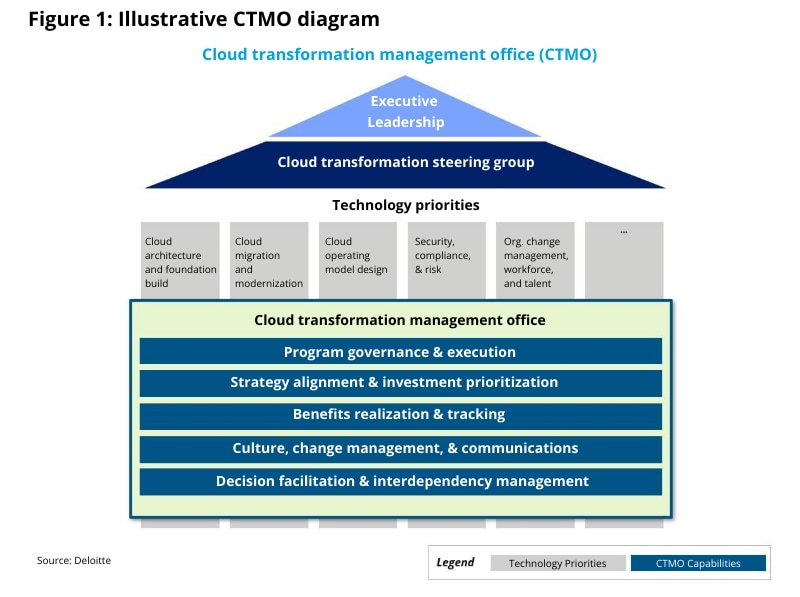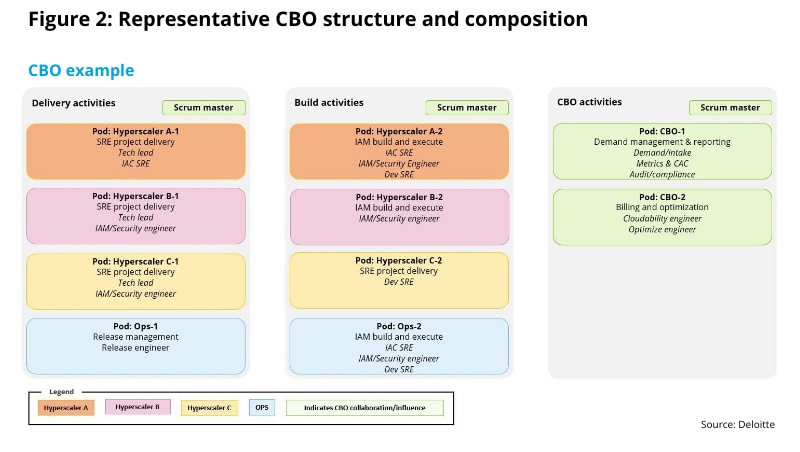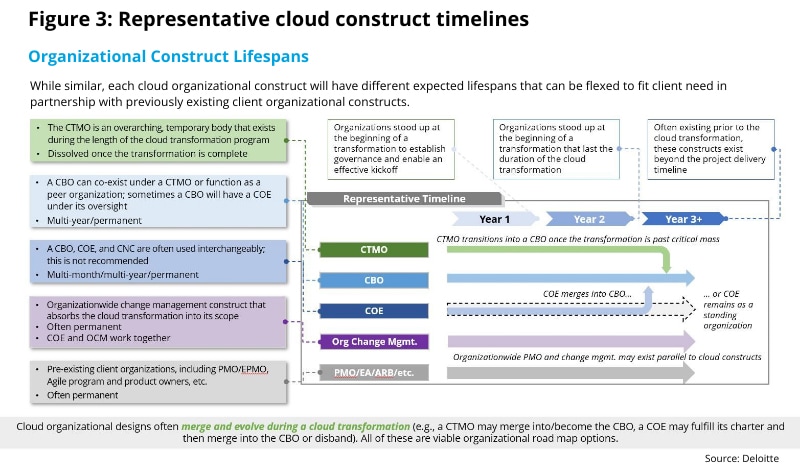Organizational Constructs for a Cloud Transformation | Deloitte US has been saved
A blog post by Tim Potter, Principal, Deloitte Consulting LLP, Technology Strategy and Cloud Engineering; Ketaki Potkar, Senior Manager, Deloitte Consulting LLP, Cloud Services; Mitchell Felknor, Senior Manager, Deloitte Consulting LLP, Cloud Services
Cloud computing is transformational for many organizations. Planning for and adopting cloud requires a thoughtful approach. Many who started their journey to cloud years ago are revisiting and evolving their strategy. One of the first decisions organizations need to make as they look to adopt cloud is who will lead the charge. Is the cloud shift an initiative driven by the IT organization? A host of questions follow, including:
- How involved are the business application development teams, enterprise risk, and operations?
- What teams and organizational constructs do you need for a effective cloud transformation?
Depending on these choices and decisions, the organizational constructs needed to enable effective execution of a cloud adoption initiative will vary. Typically, a cloud transformation involves migrating your applications (workloads), data, and supporting IT capabilities to the cloud while aligning the IT organization, operating model, and operations and support capabilities to be more agile and nimble. A cloud transformation fundamentally changes the structure, organization, and strategy of a business unit, IT organization, or the entire enterprise.
Constructs to enable cloud transformations
Cloud transformation management office (CTMO)
A CTMO is an overarching organization that is charged with driving, managing, and ensuring net positive results from a cloud transformation initiative. A CTMO is established early in a cloud transformation life cycle. It operates throughout the greatest period of change and until the targeted benefits are realized or are clearly on track to be realized.
A CTMO should define the workstreams required to achieve the goals for the cloud transformation. Each transformation is different, and workstream definition and structure will vary by organization. However, the following are typical cloud transformation workstreams or pillars:
- Cloud architecture and foundation build
- Cloud migration and modernization (of infrastructure and workloads)
- Cloud operating model design
- Security, compliance, and risk
- Organizational change management, workforce, and talent
- Cloud financial operations (FinOps)
- Facilities and vendor management
- Innovation*
- Data and analytics*
- Agile transformation*
*Innovation, data and analytics, and agile transformation pillars are often transformation programs that are executed in concert with a cloud transformation.
The CTMO plays a critical role in aligning the execution of work across workstreams supporting the cloud transformation. A CTMO proactively identifies and resolves dependencies and risks workstreams. Further, the CTMO provides value delivery reporting to executive leadership and highlights execution challenges that require executive support to resolve. A CTMO provides a single point of accountability for the overall cloud transformation while providing space for innovation and operational freedom within each of the workstreams.
Cloud business office (CBO)
A CBO is typically a permanent organizational unit that is responsible for demand management, cloud financial operations (FinOps), enablement, training, communications, and outreach. Simply put, the CBO is focused on business management of the cloud. By efficiently managing the demand for cloud services, the CBO ensures that resources are allocated effectively, costs are optimized, and the organization gets the most value from its cloud investments.
Cloud center of excellence (CCOE)
A CCOE is an organizational construct focused on enabling or accelerating capabilities in support of a cloud transformation. Organizations will charter a CCOE to provide a forum for the organization to define leading practices and patterns that, over time, are formalized into standards in consolidation with enterprise architecture. Companies often form communities of interest within the umbrella CCOE to focus on specific emerging cloud topics (e.g., observability, generative AI).
A CCOE may receive funding from the CTMO or central CBO for community building and training purposes. That being the case, the most effective CCOEs are self-governing and led by employees passionate in specific topics. Over time, a CCOE (and its subcommunities) may be disbanded or merged into the CBO enablement function.
Organizational lifespans
As we have suggested above, the CTMO and CCOE typically last throughout the cloud transformation process and eventually are absorbed into the CBO when cloud becomes the standard mode of operations. In some instances the concept of CCOE will persist and evolve to focus on new emerging technology domains.
Cloud transformations can be complex and challenging to execute given the magnitude of change to a broad set of organizational functions. Putting in place the optimal constructs to drive the transformation is a critical success factor. As you embark on your cloud journey (or consider pivoting your current approach), consider a CTMO (transformation orchestration), CBO (business management), and CCOE (capability enablement).
Get in touch

Tim Potter
Tim is a principal in Deloitte Consulting LLP’s Technology Strategy and Engineering practice and serves as Deloitte’s US Engineering Leader for Insurance, Investment Management, and Real Estate sectors. He has more than 20 years of strategy consulting and technology transformation experience and has worked with Fortune 500 organizations around the world. Tim has extensive experience partnering with senior executives to define business-led technology transformation strategies, establish executable implementation roadmaps, and shift an organization's operating model to capture the full benefits of a...




